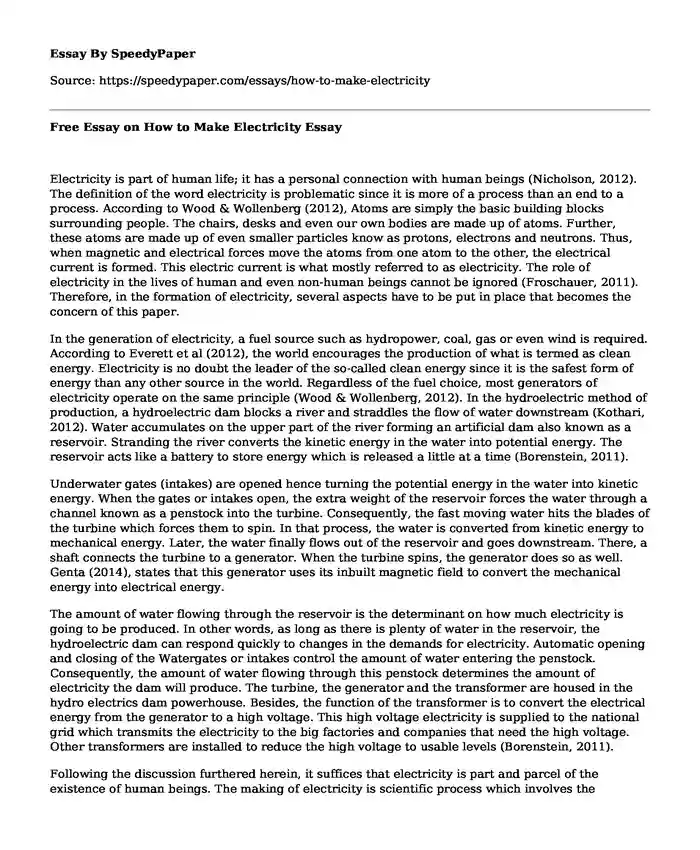Electricity is part of human life; it has a personal connection with human beings (Nicholson, 2012). The definition of the word electricity is problematic since it is more of a process than an end to a process. According to Wood & Wollenberg (2012), Atoms are simply the basic building blocks surrounding people. The chairs, desks and even our own bodies are made up of atoms. Further, these atoms are made up of even smaller particles know as protons, electrons and neutrons. Thus, when magnetic and electrical forces move the atoms from one atom to the other, the electrical current is formed. This electric current is what mostly referred to as electricity. The role of electricity in the lives of human and even non-human beings cannot be ignored (Froschauer, 2011). Therefore, in the formation of electricity, several aspects have to be put in place that becomes the concern of this paper.
In the generation of electricity, a fuel source such as hydropower, coal, gas or even wind is required. According to Everett et al (2012), the world encourages the production of what is termed as clean energy. Electricity is no doubt the leader of the so-called clean energy since it is the safest form of energy than any other source in the world. Regardless of the fuel choice, most generators of electricity operate on the same principle (Wood & Wollenberg, 2012). In the hydroelectric method of production, a hydroelectric dam blocks a river and straddles the flow of water downstream (Kothari, 2012). Water accumulates on the upper part of the river forming an artificial dam also known as a reservoir. Stranding the river converts the kinetic energy in the water into potential energy. The reservoir acts like a battery to store energy which is released a little at a time (Borenstein, 2011).
Underwater gates (intakes) are opened hence turning the potential energy in the water into kinetic energy. When the gates or intakes open, the extra weight of the reservoir forces the water through a channel known as a penstock into the turbine. Consequently, the fast moving water hits the blades of the turbine which forces them to spin. In that process, the water is converted from kinetic energy to mechanical energy. Later, the water finally flows out of the reservoir and goes downstream. There, a shaft connects the turbine to a generator. When the turbine spins, the generator does so as well. Genta (2014), states that this generator uses its inbuilt magnetic field to convert the mechanical energy into electrical energy.
The amount of water flowing through the reservoir is the determinant on how much electricity is going to be produced. In other words, as long as there is plenty of water in the reservoir, the hydroelectric dam can respond quickly to changes in the demands for electricity. Automatic opening and closing of the Watergates or intakes control the amount of water entering the penstock. Consequently, the amount of water flowing through this penstock determines the amount of electricity the dam will produce. The turbine, the generator and the transformer are housed in the hydro electrics dam powerhouse. Besides, the function of the transformer is to convert the electrical energy from the generator to a high voltage. This high voltage electricity is supplied to the national grid which transmits the electricity to the big factories and companies that need the high voltage. Other transformers are installed to reduce the high voltage to usable levels (Borenstein, 2011).
Following the discussion furthered herein, it suffices that electricity is part and parcel of the existence of human beings. The making of electricity is scientific process which involves the conversion of kinetic energy to potential and vice versa. Further, the conversion of mechanical energy to electrical energy happens in the transformer. The importance of water in the hydroelectric making of electricity has been underscored as the major mover of the turbine which in turn rotates to produce kinetic energy. The absence of enough water in the reservoir can cause black-outs since only a small amount of electricity will be made. Additionally, the process of intake of water into and out of the reservoir has been extrapolated. Also, the place of transformers and generators is the production process has been examined as the convertors of mechanical energy into electrical energy. Finally, the conversion of high voltage to low voltage by use of transformers has been successfully explained to be the role of small transformers.
References
Borenstein, S. (2011). The private and public economics of renewable electricity generation (No. w17695). National Bureau of Economic Research.
Everett, R., Boyle, G., Peake, S., & Ramage, J. (2012). Energy systems and sustainability: power for a sustainable future. Oxford Univerity Press.
Froschauer, K. (2011). White gold: hydroelectric power in Canada. UBC Press.
Genta, G. (2014). Kinetic energy storage: theory and practice of advanced flywheel systems. Butterworth-Heinemann.
Kothari, D. P. (2012, March). Power system optimization. In Computational Intelligence and Signal Processing (CISP), 2012 2nd National Conference on(pp. 18-21). IEEE.
Nicholson, M. (2012). What is Electricity?. In The Power Makers' Challenge(pp. 3-7). Springer London.
Wood, A. J., & Wollenberg, B. F. (2012). Power generation, operation, and control. John Wiley & Sons.
Cite this page
Free Essay on How to Make Electricity. (2019, May 31). Retrieved from https://speedypaper.com/essays/how-to-make-electricity
Request Removal
If you are the original author of this essay and no longer wish to have it published on the SpeedyPaper website, please click below to request its removal:
- Equal Rights for Men and Women - Essay Example
- Essay Sample on How Having a Pet Benefits to Child
- Free Essay on the LGBT Movement
- Floating Egg Kitchen Experiment - Coursework Paper Example
- Seeking Love: Patterns in Ads 1-8
- Most Memorable Day of My Life. Essay Sample
- Free Essay for You: Racism in the Novel - The Hate U Give
Popular categories





